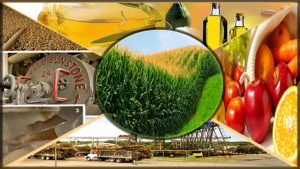Introduction
Fertilizers are important for proper growth and proper functioning of plant. Nitrogen, Phosphorous and Potassium are necessary for plant. Nitrogen is an important component of protein and protoplasm, its shortage lead to yellowing of leaves and stops the growth of plant. Phosphorous is necessary part of the nucleic acid as well as structure of plants, which regulate protein synthesis. Phosphorous is also required in cell division and expansion of new tissue. Potassium is important because it stimulate early growth; improve resistance to disease and insects. But use of excess fertilizers to agricultural soils leads to agricultural pollution which deteriorate the environmental quality. But here we will discuss about fate of nitrate fertilizers Use in agricultural soils.
Fates of Nitrate fertilizers
When Nitrogen fertilizer is applied to crop, most of it is uptake by plant, while some remains in soil and some is lost from the system. The amount of each part depends on wide range of factors Such as weather conditions, soil type and timing of fertilizer application or type of crops. Increasing disperse of nitrate into surface and ground water has appeared as a major problem in agricultural lands of the world, due to this contamination of drinking water reservoirs as well as eutrophication of fresh water and marine ecosystem occur. Leaching of fertilizers in nitrate form indicates the wastage of costly fertilizers as well as possible deterioration of groundwater. An experiment conducted by Irrigation and Drainage department, University of Agriculture, Faisalabad, to observe the leaching behavior of nitrate in surface irrigated field. Take two soil water samples. The results showed that keeping all other parameters constant i.e. irrigation depth, tillage practices, the nitrate-nitrogen leaching was affected by the rate of fertilizer. The nitrate-nitrogen leaching was about 15% more after fourth irrigation at 85 cm depth as fertilizer rate increased from 125 to 185kg/ha. The tail end of fields had 8% more nitrate compared with stream ends which showed that movement of nitrates with Water.
The agricultural chemicals used in injudiciously without considering their toxic side effects. Fertilizers are poisonous for animals and human beings. The nutrients applied for increasing crop production are subjected to various losses and transformations in soil. Nitrogen, being the most deficient and crucial plant nutrient, is applied in large amount in the form of chemical fertilizer to meet the demand of high yielding crop varieties. A considerable part of the nitrogenous fertilizer is lost through volatilization, denitrification and leaching in the form of nitrate which becomes a source of environmental pollution (Gill, 1978). Nitrogen loss through leaching is due to movement of NO3-N with water.
There are two major disadvantages of nitrogen leaching. On one hand leaching results in loss of costly fertilizers and most of our valuable resources are utilized for its manufacturing. On the other hand leaching material may pollute the ground water which is mostly used for drinking without treatment. Groundwater pollution is increasing concern in Pakistan because 50-60% of our drinking water comes from ground water source (Sial et al, 1993).
Environmental effects
- Water:
The nitrogen rich compound found fertilizer runoff is primary cause of serious oxygen depletion in many areas of oceans like in coastal zones, lakes and rivers. As a result lack of dissolved oxygen is greatly reduces the ability of these areas to sustain oceanic fauna. If eutrophication can reverse, it may takes decades before the accumulated nitrates in ground water can be broken down by natural process.
- Nitrate pollution:
Only a small amount of the nitrogen based fertilizer is converted to product and other plant matter. The remaining part is accumulate in soil or lost as runoff, high application rate of nitrate containing fertilizer combine with high water solubility of nitrate cause to increased runoff into surface water as well as leach down into ground water and cause ground water pollution. The excessive use of nitrogen is harmful because not complete nitrogen is taken up by plant and it is transformed into nitrate which is easily leached. Nitrate levels above 10mg/L in ground water can cause blue baby syndrome. Nitrate may create problems for natural habitats as well as for human heath if they are move away from soil into water courses or leached through soil into ground water.
- Soil
Nitrogen fertilizers may cause soil acidification, when this is added into the soil this may lead to decreases in nutrient availability which can be offset by liming. High level of fertilizer may cause the breakdown of the symbiotic relationship between plant roots and mycorrhizal fungi.
- Atmosphere
Through the increasing use of nitrogen fertilizer which was used at the rate of about 110 million per year in 2012, adding to the already existing amount of reactive nitrogen, nitrous oxides has become the third very important green house gas after carbon dioxide and methane. It has global warming potential 296 times larger than same mass of carbon dioxide and it also play role to stratosphere ozone depletion. By changing processes and procedures, it may effects on anthropogenic climate change. Methane emissions from crop field are increased by application of nitrogenous fertilizers. The emission of gas contributes to global climate change because methane is a potent green house gas.
Conclusion
Fertilizers are plant nutrient therefore plant requires fertilizers for their proper growth and functioning but if we use amount of fertilizers other than recommended amount it would
Be dangerous for plant, human as well as environment because over or under fertilization may disturb plant functioning, for human it may creates health problem and for environment it may cause pollution and deteriorate environmental quality. Therefore we should use only recommended quantity of fertilizers to escape from economic loss as well as to save environment.
Written by:
Muhammad Wasim Akram, Department of Entomology, University of Sargodha
Co-authors: Rao Adeel Ur Rehman,Muhammad Neem Qaisar khan, Moin Ahmad(department of Food Science) GCUF, Sahiwal Campus








